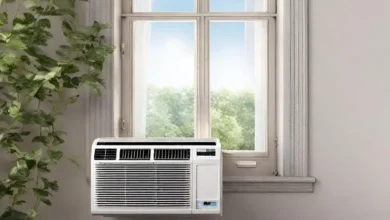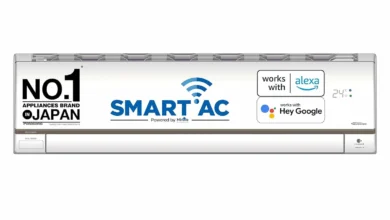3 Star vs 5 Star Air Conditioner: Which is Better to Buy?

In the scorching heat of tropical climates like India, air conditioners have become indispensable, providing a respite from the oppressive temperatures. However, the increasing demand for these cooling appliances has led to a growing concern about their environmental impact and energy consumption. In this context, comprehending the significance of star ratings becomes imperative for consumers looking to make an informed decision about best air air conditioner in India choices.
Star ratings are not just arbitrary numbers but rather a systematic evaluation of an air conditioner’s energy efficiency and cooling capabilities. These ratings are assigned by the Bureau of Energy Efficiency (BEE), a regulatory body under the Indian government. The BEE’s role in this context is crucial as it aims to promote sustainable and energy-efficient practices in various sectors, including the rapidly expanding air conditioning industry.
The star ratings, ranging from 1 to 5 stars, provide consumers with a quick and easy way to assess the efficiency of an air conditioner. The higher the star rating, the more energy-efficient the appliance is expected to be. This implies that a 5-star rated AC consumes less electricity compared to a 3-star rated one while delivering the same or even superior cooling performance. Consequently, opting for a higher star-rated air conditioner not only translates to potential cost savings on electricity bills but also contributes to reducing the overall environmental impact.
The BEE employs a rigorous testing process to determine these star ratings, considering factors such as the seasonal energy efficiency ratio (SEER) and the energy efficiency ratio (EER). SEER reflects the cooling output of an AC over an entire cooling season, while EER measures its efficiency at a specific operating point. The combination of these metrics ensures a comprehensive evaluation, providing consumers with a well-rounded understanding of an air conditioner’s performance.
One of the primary advantages of understanding and considering star ratings is the positive impact on environmental sustainability. Energy-efficient appliances help reduce the overall carbon footprint, as they consume less electricity and, consequently, lower greenhouse gas emissions. In a country like India, where the demand for air conditioning is steadily rising, making eco-conscious choices can collectively contribute to a more sustainable future.
Decoding Star Ratings: A Consumer’s Guide
In the complex landscape of electrical appliances, particularly air conditioners, deciphering the meaning behind those star ratings is an essential skill for any consumer. This segment serves as a consumer-friendly guide, shedding light on the window-shaped sticker adorned with five stars, acting as a visual compass for gauging an AC’s energy efficiency. Additionally, it delves into key indicators such as ‘more stars more savings’ and the ISEER measure, providing consumers with the knowledge needed to make educated decisions in the realm of cooling solutions.
The window-shaped sticker on an air conditioner, featuring a varying number of stars, is not just a decorative element; it’s a wealth of information for consumers. The stars serve as a quick reference guide to the energy efficiency of the appliance, with more stars indicating higher efficiency. This simple visual representation is a powerful tool for consumers looking to balance the desire for a cool and comfortable living space with the goal of minimizing energy consumption.
The mantra ‘more stars more savings’ encapsulates a fundamental principle of air conditioner shopping. Understanding this phrase is crucial for consumers aiming to optimize both their comfort and their budget. In essence, it signifies that higher star-rated air conditioners tend to consume less electricity while delivering the same or better cooling performance. This not only translates to immediate savings on electricity bills but also contributes to long-term cost-effectiveness.
An additional metric that consumers should be acquainted with is the Indian Seasonal Energy Efficiency Ratio (ISEER). This comprehensive measure takes into account various factors such as part-load efficiency and part-load degradation to provide a more accurate assessment of an air conditioner’s overall performance. Unlike a single-point efficiency ratio, the ISEER offers a holistic view, ensuring that consumers are well-informed about an AC’s efficiency across different operating conditions.
Empowering consumers with this knowledge is not just about making a purchase; it’s about making a well-informed and efficient choice. In a market flooded with options, understanding star ratings and related indicators allows consumers to align their cooling preferences with their environmental and financial goals. It’s a step towards a more sustainable and cost-effective approach to cooling solutions, ensuring that every purchase contributes not only to personal comfort but also to a greener and more energy-conscious future.
Calculating Energy Efficiency: The SEER Ratio
In the realm of air conditioners, understanding the Seasonal Energy Efficiency Ratio (SEER) is paramount for consumers looking to make informed decisions about their cooling systems. The SEER is a fundamental metric that quantifies the performance of an air conditioner by evaluating the net amount of heat absorbed versus the net energy consumed. This section elucidates the intricacies of the calculation process, providing buyers with a comprehensive understanding that empowers them to make nuanced comparisons between different AC models based on their energy efficiency.
At its core, the SEER ratio serves as a yardstick to measure how effectively an air conditioner operates over an entire cooling season. The calculation involves assessing the total cooling output of the AC unit and dividing it by the total electricity consumed during the same period. The resulting SEER ratio is an indicative measure of the appliance’s efficiency in converting electrical energy into cooling power.
The calculation process can be broken down into two primary components:
- Total Cooling Output (in BTUs): This refers to the amount of heat that the air conditioner can remove from the indoor air during the cooling season. It accounts for the AC’s ability to maintain a comfortable temperature in various conditions.
- Total Electricity Consumption (in watt-hours): This quantifies the total energy consumed by the air conditioner over the entire cooling season. It encompasses the energy used for compressing refrigerant, circulating air, and other operational functions.
The SEER ratio is then determined by dividing the Total Cooling Output by the Total Electricity Consumption. A higher SEER rating implies a more energy-efficient air conditioner, as it indicates that the unit can deliver a greater amount of cooling per unit of electricity consumed.
For consumers, grasping the SEER ratio provides a valuable tool for making nuanced comparisons between different AC models. Opting for a higher SEER-rated air conditioner not only aligns with environmental sustainability goals but can also result in long-term cost savings on electricity bills. However, it’s essential to strike a balance between SEER ratings and specific cooling needs, as a higher SEER rating may come with a higher upfront cost.
Evaluating the Cost Factor
Dispelling the myth that higher star-rated air conditioners inevitably carry a prohibitive price tag, this segment delves into the intricate cost dynamics associated with purchasing air conditioning units. By addressing the common misconception and recognizing the initial investment, this section emphasizes the long-term savings potential, encompassing reduced electricity bills and maintenance costs. It underscores the importance of viewing the upfront cost not as an expense but as a strategic investment in energy efficiency and sustainable cooling solutions.
One prevailing misconception in the air conditioner market is the belief that opting for a higher star-rated appliance translates into a significant upfront expense. However, this segment aims to unravel the cost dynamics to reveal a more nuanced perspective. While it is true that air conditioners with higher star ratings might have a slightly elevated initial cost, it is imperative for consumers to shift their focus from the upfront expenditure to the long-term advantages associated with such investments.
The key consideration here is the substantial reduction in electricity bills that accompanies higher star-rated air conditioners. These energy-efficient appliances are designed to consume less electricity while maintaining optimal cooling performance. Over time, the cumulative savings on energy costs can offset the initial higher purchase price. This not only results in significant financial benefits for consumers but also aligns with environmentally conscious practices by reducing overall energy consumption.
Moreover, higher star-rated ACs often come with advanced technologies and superior build quality. This can contribute to lower maintenance costs over the lifespan of the appliance. The durability and efficiency of these models can lead to fewer breakdowns and repairs, further adding to the long-term economic advantages.
It’s crucial for consumers to perceive the upfront cost of a higher star-rated air conditioner as a strategic investment rather than a mere expense. By prioritizing energy efficiency, individuals are not only making a wise financial decision but also contributing to sustainable practices. The long-term savings, both in terms of reduced energy consumption and maintenance expenses, underscore the value proposition of these appliances.
In conclusion, while the initial cost of a higher star-rated air conditioner might be marginally higher, a holistic evaluation reveals the substantial benefits over time. This segment encourages consumers to adopt a forward-thinking approach, recognizing the upfront investment as a strategic move toward energy efficiency and long-term cost savings, ultimately contributing to a more sustainable and economical cooling solution.
Comparing 3-Star and 5-Star ACs
The perennial debate between 3-star and 5-star air conditioners persists as a crucial decision point for consumers navigating the cooling appliance market. This section aims to provide a comprehensive analysis of both options, dissecting their respective advantages and disadvantages. By delving into the nuances of each star rating, consumers can make informed choices that align with their specific cooling needs, usage patterns, and budget constraints.
3-Star ACs: Striking a Balance
Advantages:
- Cost-Effective Initial Investment: 3-star rated air conditioners often come with a more budget-friendly upfront cost compared to their 5-star counterparts. This makes them an attractive option for consumers seeking a balance between performance and affordability.
- Energy Efficiency: While not the highest on the scale, 3-star ACs still exhibit a commendable level of energy efficiency. They provide a reasonable compromise, offering decent cooling performance without a substantial increase in electricity consumption.
- Wider Range of Options: The market for 3-star rated ACs is extensive, providing consumers with a broader array of choices in terms of brands, models, and features. This variety allows buyers to find a unit that best suits their specific requirements.
Disadvantages:
- Moderate Energy Savings: In comparison to 5-star ACs, the energy savings with a 3-star rated appliance may be moderate. While they are more efficient than lower-rated models, they might not deliver the same level of long-term cost savings on electricity bills.
- Environmental Impact: Although more energy-efficient than lower-rated models, 3-star ACs still contribute to electricity consumption and environmental impact. Consumers prioritizing sustainability might find 5-star models more aligned with their goals.
5-Star ACs: The Pinnacle of Efficiency
Advantages:
- Maximum Energy Efficiency: 5-star ACs stand at the pinnacle of energy efficiency, offering the highest level of performance while consuming the least amount of electricity. This translates to significant long-term savings on energy bills.
- Environmentally Conscious Choice: Opting for a 5-star rated AC reflects a commitment to environmental sustainability. The reduced energy consumption contributes to lower greenhouse gas emissions, aligning with eco-friendly practices.
- Advanced Features: Higher-rated models often come equipped with advanced technologies and features that enhance overall performance. These may include smart cooling options, improved air quality measures, and better temperature control.
Disadvantages:
- Higher Initial Cost: The main drawback of 5-star ACs is their relatively higher upfront cost. Consumers need to weigh this against the potential long-term savings and environmental benefits.
- Narrower Model Selection: The market for 5-star ACs might be more limited compared to lower-rated models. Consumers may find fewer options in terms of brands and features, requiring careful consideration of individual preferences.
Maximizing Savings on Investment Cost
Guiding consumers through the process of maximizing savings, this segment emphasizes the importance of analyzing individual AC needs. By providing actionable insights into usage duration and cooling intensity, buyers can make informed decisions regarding the upfront cost, ensuring their investment aligns with their long-term financial goals.
Choosing Between 3-Star and 5-Star ACs
Delving into the heart of consumer decision-making, this section assists potential buyers in choosing between 3-star and 5-star ACs. By comparing energy ratings, costs, and user reviews, consumers can find the optimal balance that meets their budget constraints while fulfilling their cooling requirements.
Making an Informed Choice
In the end, the choice between a 3-star and a 5-star AC boils down to a careful evaluation of individual priorities. Consumers must consider their budget constraints, long-term energy-saving goals, and environmental consciousness. While 3-star ACs provide a balanced and cost-effective option, 5-star ACs offer unparalleled energy efficiency and sustainability. By understanding the nuances of each rating, consumers can make a decision that not only suits their immediate cooling needs but also aligns with their broader objectives for efficiency and environmental responsibility.





